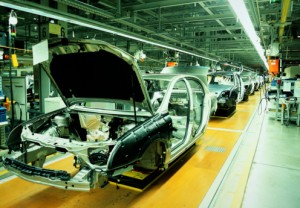Green-Collar vs. Blue-Collar Jobs: A Difference in Name Only?

(iStockphoto)
Amid ongoing inquiries into the prudence of government loans to failed solar firm Solyndra, and a spate of other bad news on the green jobs front, there is growing concern that the green economy may not be the juggernaut President Obama promised when he vowed after his election to invest $150 billion to generate “five million new green jobs that pay well and can’t be outsourced.” To counter critics, the administration is greenwashing large swaths of the economy—defining “green jobs” down to the point that they are virtually indistinguishable from what we used to call “manufacturing jobs.”
Green jobs are central to arguments that new environmental regulations should be pursued even in a down economy. Supporters of the policies, like California’s carbon cap-and-trade system, claim that even if the cost of regulatory compliance causes job losses in the traditional economy, the regulations will create jobs in the green economy. And green jobs are better jobs, as the President says: high paying, reliably American, and yielding environmental benefits.
Success of the green economy supports the economic defense of environmental policy, which may explain why administration officials were on Capitol Hill last week defending the notion that millions of Americans, from bus drivers to car makers, are employed in “green jobs.” Or why the Department of Energy is taking credit for converting half of Ford Motor Co.’s workforce to green jobs with a $5.9 billion loan to retool manufacturing plants. As a Ford spokesman told the Washington Post, the loans were used to “transform what were primarily truck/SUV plants into flexible manufacturing plants capable of building more fuel-efficient vehicles.” In other words, an assembly line position in Chicago—perhaps the quintessential blue-collar manufacturing job—becomes a coveted green job if the worker could install doors on the Ford Escape Hybrid, not just the Ford Explorer.
The administration’s operating definition of green jobs was developed by the Bureau of Labor Statistics (BLS), which, tasked in 2010 to find and count all the jobs in the green economy, first had to settle on what it should be looking for. The Bureau decided that green jobs are those that produce goods and services which benefit the environment or conserve natural resources, like renewable energy and energy-efficient products, or those that make production processes more environmentally friendly or use fewer natural resources.
The government’s definition extends green status to jobs that benefit the environment indirectly by employing processes or developing products that reduce pollution or resource consumption. But determining which jobs to credit with these indirect benefits relies on a series of arbitrary decisions that render the “green jobs” moniker essentially meaningless. How much of an indirect benefit must a process or product provide? Relative to what standard is the benefit measured? And which jobs in the supply chain are credited with the indirect benefits?

(iStockphoto)
The criteria for automobiles illustrate the problem. According to terms of the DOE’s Advanced Technology Vehicle Manufacturing loan program, which provided the loan to Ford, car manufacturing jobs are green if the cars produced get 25% more miles per gallon than the average of “substantially similar” cars. Thus, according to the DOE, a maker of the 28-MPG 2011 Toyota Highlander Hybrid holds a “green-collar job,” but the maker of a 41-MPG 2011 Honda Civic Hybrid has a plain old blue-collar job.
Why is the car that gets 13 more MPG than a “green car” not also a “green car?” And why compare cars against the average MPG of similar cars instead of the average MPG of all cars, or the average of the most efficient class of cars? With these relative standards, a job assembling the Toyota Highlander could be a green-collar job one year and a blue-collar job the next.
It’s not obvious that production of the Toyota Highlander Hybrid benefits the environment. Because of the Jevons Paradox, the driver of a Highlander Hybrid may consume more fossil fuel than the driver of a less efficient car because the fuel costs of driving the Highlander Hybrid are lower. Furthermore, an assumption of environmental gain from production of green cars implicitly makes strong assumptions about the substitution patterns of motorists. Would a 28-MPG Highlander Hybrid owner have chosen a 32-MPG Ford Escape Hybrid if the Highlander Hybrid weren’t on the market? Or a would he have chosen the 20-MPG conventional drive Toyota Highlander?
Assigning environmental benefit to producers of green products is also arbitrary. The BLS claims to assign jobs to the green economy on the basis of whether they have “apparent benefit to the environment.” According to the BLS, any job at a firm making a green product is green, including administrative and support jobs. As the BLS notes, its green jobs definition is “not based on skill differences.” But the production of green products causes pollution. Benefit to the environment often accrues only upon consumption of green products, which displaces consumption of dirtier products. For example, production of solar panels consumes resources and causes carbon emissions and other pollution; consumption of solar panels provides environmental benefit by generating clean energy that displaces fossil fuels.
In assigning green credit to manufacturers of green products, the BLS implicitly acknowledges that production of green products is essential to the generation of environmental benefit. But the BLS doesn’t extend that logic to those who distribute, market and retail green products because “BLS has concluded that transporting or selling a green good has no apparent benefit to the environment compared to transporting or selling any other good.”
Extending the green jobs definition to include work that indirectly benefits the environment, the BLS also classifies bus drivers and other mass transit workers as green-collar workers, according to Congressional testimony last week by Labor Secretary Hilda Solis, who described mass transit workers as providing “services that benefit the environment.” It also includes jobs in organic and local farming and corn-ethanol production (practices with disputed environmental benefits in general equilibrium settings), but excludes jobs in processing organic and local foods because “the processing has no apparent benefit to the environment compared to processing any other food.” Likewise, recycling is green, but using recycled material is not. By that standard, then, what is the environmental benefit of manufacturing green products like solar panels and hybrid cars?
The Obama administration’s green jobs definition constitutes a rebranding of huge swaths of the American economy. The administration has defined green jobs down to the point that they cannot be relied upon to offer the benefits that make their exchange for blue-collar jobs a winning proposition. They do not carry guarantees of higher wages, as the new “green-collar” workers at Ford’s refurbished assembly plants can surely attest. Nor are they reliably American jobs either, as the shuttering of prominent solar plants in Massachusetts and California reveal. We are losing “green jobs” to China, much like our traditional manufacturing jobs. And in many cases, the administration’s green jobs do not even deliver environmental benefits, which is, after all, their raison d’etre.
But here’s the irony. Consumption of energy-efficient and alternative energy products, like high fuel economy cars and solar panels, reduces environmental impacts relative to less efficient and fossil fuel products. Their production, however, causes pollution, which means that our loss of green product manufacturing to overseas competitors is the (American) environment’s gain.

Comments